| Label:
|
C.F. Schmidt Weimar Carl Fischer New York Sole Agent of U.S.A. and Canada Made in Germany 38783 |
|
Model:
|
Double |
|
Serial Number:
|
38783 |
|
Date of Manufacture:
|
1934 |
|
Key(s):
|
F, B♭ |
|
Valves:
|
3 rotary, 1 Périnet piston |
|
Bore:
|
|
|
Bell Flare:
|
|
|
Bell Throat:
|
|
|
Bell Diameter:
|
|
|
Base Metal:
|
brass |
|
Finish:
|
unlacquered |
| .
|
|

|
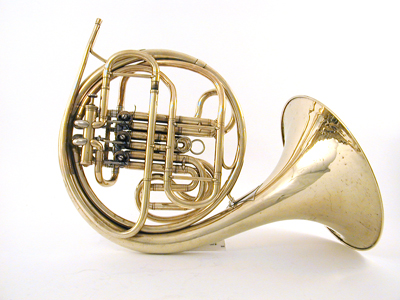 |
The firm of Ed. Kruspe in Erfurt, Germany developed the first double horn in F and B♭ in 1897 with tandem rotors for the change valve, which many sources incorrectly state was a "compensating" horn. Three years later C.F. Schmidt in Berlin came out with the its double horn incorporating a piston for the change valve. In a letter to Osbourne McConathy dated July 3, 1956, Anton Horner described his role in the development of the Schmidt double horn in 1900:To go a little farther with the development of the double horn, I must tell you that in 1900 I was engaged to go to the Paris Exposition, and to tour Europe with Sousa's Band... So even in Berlin, my reputation had spread, and Schmidt, the horn maker, who was first in Weimar, and now had his factory in Berlin, came to talk to me. He had invented a new B valve for a double horn, but could not decide what kind of mouthpiece tube was best for his new instrument. He asked me to come to his factory to help him decide. I went to his place, and after long trials of several mouthpiece tubes, I approved of one which he used on his first instruments in F an B. His B valve was a piston, like on a cornet, which I found very awkward to operate with the thumb.Of course Horner is best known for his involvement with Ed. Kruspe and the development of the "Modelle Horner" a few years later, which he played for the rest of his career and advocated for his students. Despite Horner's preference for the Kruspe horn, the Schmidt model became very popular in the first half of the twentieth century among professionals, amateurs, and students. It was copied by numerous manufacturers including Conn, Alexander, and Carl Geyer, often incorporating parts imported from Schmidt. |
|
Carl Fischer was officially the sole authorized importer to the U.S. and Canada representing Schmidt, however many horns were imported directly from Germany. or as parts to be assembled here to avoid tariffs. During the course of its history the Schmidt workshop moved between Berlin and Weimar several times. The location and the wording of the label provide clues to the date of the horn. Carl Fischer assigned serial numbers to the instruments they sold which when combined with the label information provide a key to the date of the horn. Unfortunately no list of Fischer serial numbers has been preserved but an empirical table has been constructed. The date of this particular instrument is confirmed by the son of the original owner to 1934. |
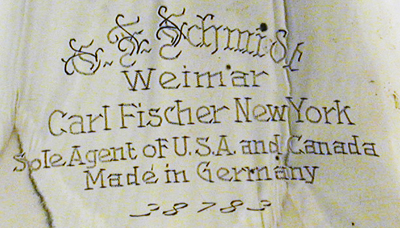 |
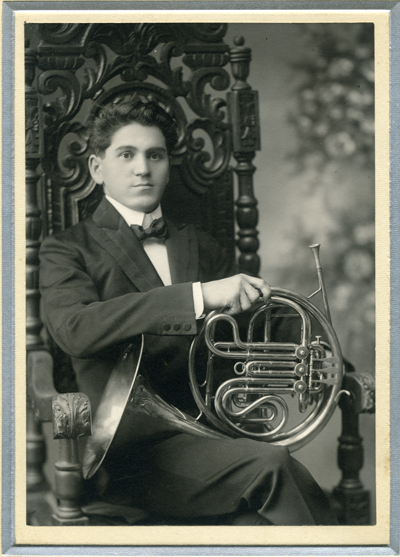 |
Josef Franzl (1882 - 1955) was an important hornist in the U.S. in the first half of the twentieth century. He was born in Czechoslovakia and studied horn with Anton Janousek at the Prague Conservatory. Before emigrating to the United States he appeared as a soloist in Czechoslovakia and Paris. According to his obituary he made his debut in the United States with the Pittsburgh Symphony Orchestra. In 1905 he toured as solo horn with Frederick Neil Innes' famous Concert Band. He was for many years a soloist with the New York Symphony under Walter Damrosch, the New York Chamber Music Society, the Kneisel Quartet, the Mannes Trio, the Georges Barrère Ensemble of Wind Instruments and the Columbia Broadcasting System Concert Orchestra. He also played during summers with the Chicago Symphony Orchestra and performed in the orchestra for operas produced at the New York City Center. |
John Barrows (1913 - 1974) attended the Eastman School of Music, San Diego State Teachers College, and Yale University. His teachers included Richard Donovan and David Smith. In 1938, after his studies at Yale, he joined the Minneapolis Symphony, playing there for four years. During the Second World War he served in the Army Air Forces Band. Following the war he settled in New York, playing with the City Opera and the City Ballet. He also appeared in San Juan, Puerto Rico with the Casals Festival Orchestra and from time to time worked with popular artists of the day including Woody Herman, Miles Davis, and Billie Holiday. |
 |
 |
Robert Schulze (1896 - 1971) was fourth horn in the New York Philharmonic from 1916 until after 1947. His full name was Hermann Robert Guenther Schulze but in the U.S. he preferred to use Robert Herman Schulze. He was born in Wiesbaden, Nassau, Germany on April 28, 1896, the son of Gustav and Martha Schulze and the younger brother of Adolph Schulze. Both his father and brother were musicians, the latter also a horn player in the N.Y. Philharmonic. He arrived in New York at the age of 15, accompanied by his father on May 18, 1911 on the ship Pennsylvania. He became a naturalized citizen of the United States on November 16, 1925. His students at Juilliard included Norman Greenberg, Marvin Howe, and Ellen Stone. Other students include Louis Stout and Gunther Schuller who calls him "one of the two major teachers in New York." Robert Schulze died in Celle, Germany on May 24, 1971 at the age of seventy-five. |
|
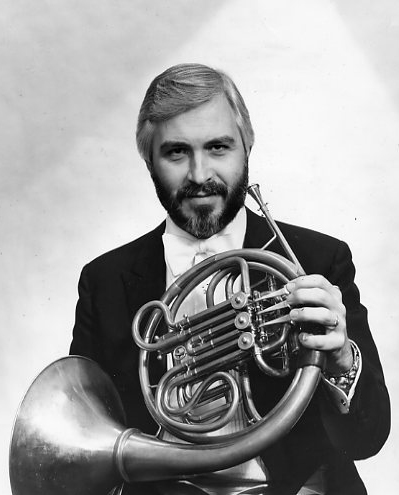 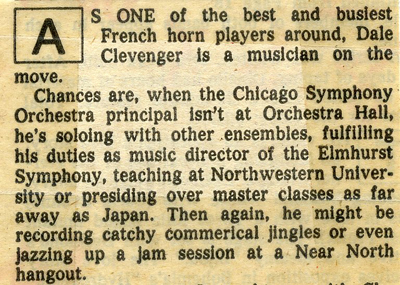 (photo and clipping dated December 13, 1981)
|
 |
 |
| |
|
|
|
|